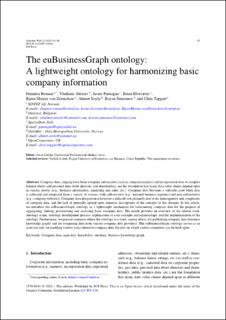| dc.contributor.author | Roman, Dumitru | |
| dc.contributor.author | Alexiev, Vladimir | |
| dc.contributor.author | Paniagua, Javier | |
| dc.contributor.author | Elvesæter, Brian | |
| dc.contributor.author | Zernichow, Bjørn Marius von | |
| dc.contributor.author | Soylu, Ahmet | |
| dc.contributor.author | Simeonov, Boyan | |
| dc.contributor.author | Taggart, Chris | |
| dc.date.accessioned | 2022-02-21T14:39:11Z | |
| dc.date.available | 2022-02-21T14:39:11Z | |
| dc.date.created | 2021-02-02T14:15:37Z | |
| dc.date.issued | 2022-11-25 | |
| dc.identifier.issn | 1570-0844 | |
| dc.identifier.uri | https://hdl.handle.net/11250/2980609 | |
| dc.description.abstract | Company data, ranging from basic company information such as company name(s) and incorporation date to complex balance sheets and personal data about directors and shareholders, are the foundation that many data value chains depend upon in various sectors (e.g., business information, marketing and sales, etc.). Company data becomes a valuable asset when data is collected and integrated from a variety of sources, both authoritative (e.g., national business registers) and non-authoritative (e.g., company websites). Company data integration is however a difficult task primarily due to the heterogeneity and complexity of company data, and the lack of generally agreed upon semantic descriptions of the concepts in this domain. In this article, we introduce the euBusinessGraph ontology as a lightweight mechanism for harmonising company data for the purpose of aggregating, linking, provisioning and analysing basic company data. The article provides an overview of the related work, ontology scope, ontology development process, explanations of core concepts and relationships, and the implementation of the ontology. Furthermore, we present scenarios where the ontology was used, among others, for publishing company data (business knowledge graph) and for comparing data from various company data providers. The euBusinessGraph ontology serves as an asset not only for enabling various tasks related to company data but also on which various extensions can be built upon. | en_US |
| dc.description.sponsorship | The work in this article was partly funded by the EC H2020 projects euBusinessGraph (grant 732003), EW-Shopp (grant 732590), TheyBuyForYou (780247), CIMA (grant BG16RFOP002-1.005-0168-C01) | en_US |
| dc.language.iso | eng | en_US |
| dc.publisher | IOS Press | en_US |
| dc.relation.ispartofseries | Semantic Web Journal;Vol. 13, no. 1 | |
| dc.relation.uri | https://content.iospress.com/articles/semantic-web/sw210424 | |
| dc.rights | Navngivelse 4.0 Internasjonal | * |
| dc.rights.uri | http://creativecommons.org/licenses/by/4.0/deed.no | * |
| dc.subject | Company data | en_US |
| dc.subject | Open data | en_US |
| dc.subject | Linked data | en_US |
| dc.subject | Ontologies | en_US |
| dc.subject | Business knowledge graphs | en_US |
| dc.title | The euBusinessGraph Ontology: a Lightweight Ontology for Harmonizing Basic Company Information | en_US |
| dc.type | Peer reviewed | en_US |
| dc.type | Journal article | en_US |
| dc.description.version | publishedVersion | en_US |
| dc.rights.holder | © 2022 – The authors | en_US |
| cristin.ispublished | true | |
| cristin.fulltext | postprint | |
| cristin.qualitycode | 1 | |
| dc.identifier.doi | https://doi.org/10.3233/SW-210424 | |
| dc.identifier.cristin | 1885913 | |
| dc.source.journal | Semantic Web Journal | en_US |
| dc.source.volume | 13 | en_US |
| dc.source.issue | 1 | en_US |
| dc.source.pagenumber | 41-68 | en_US |

